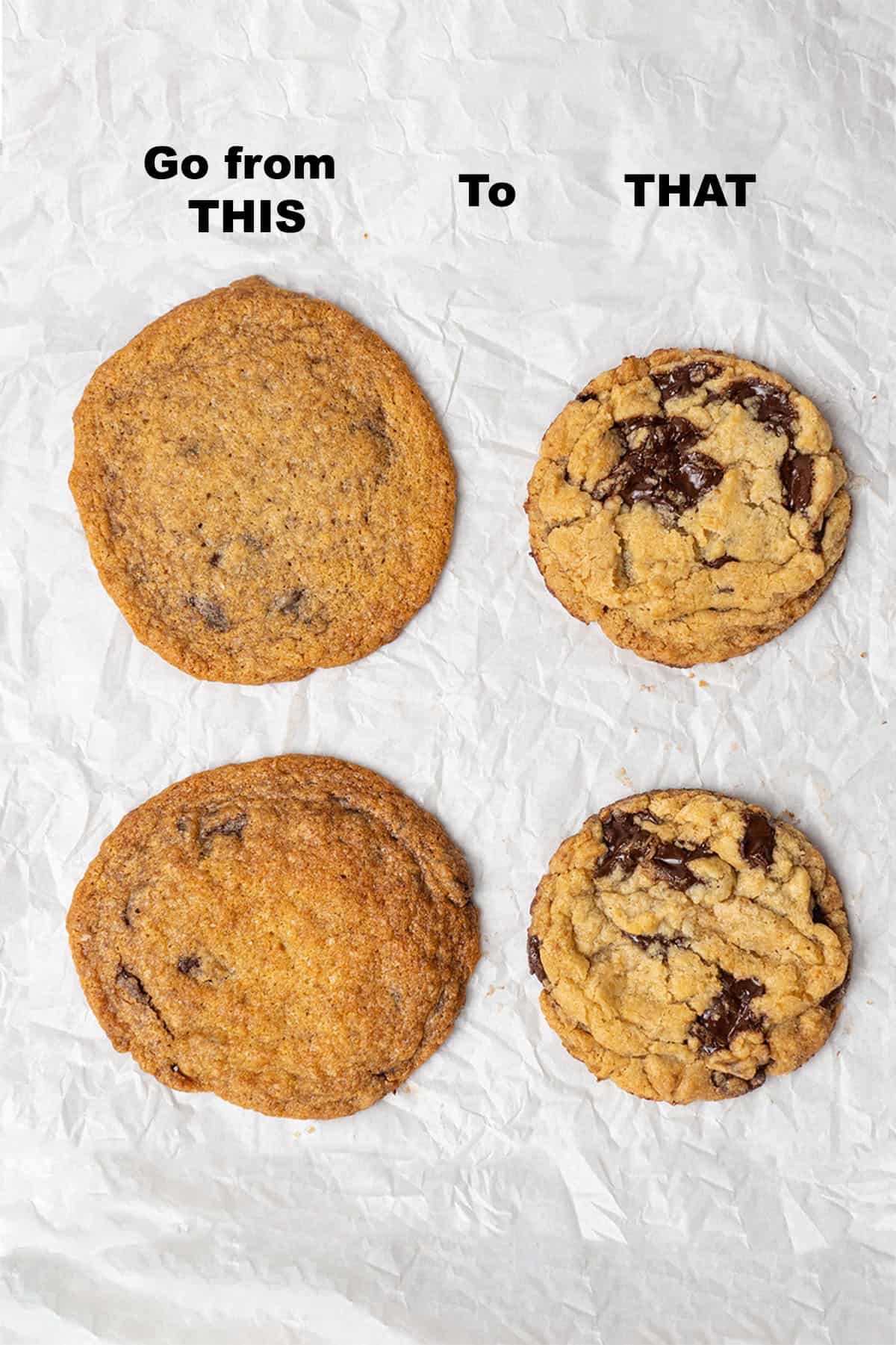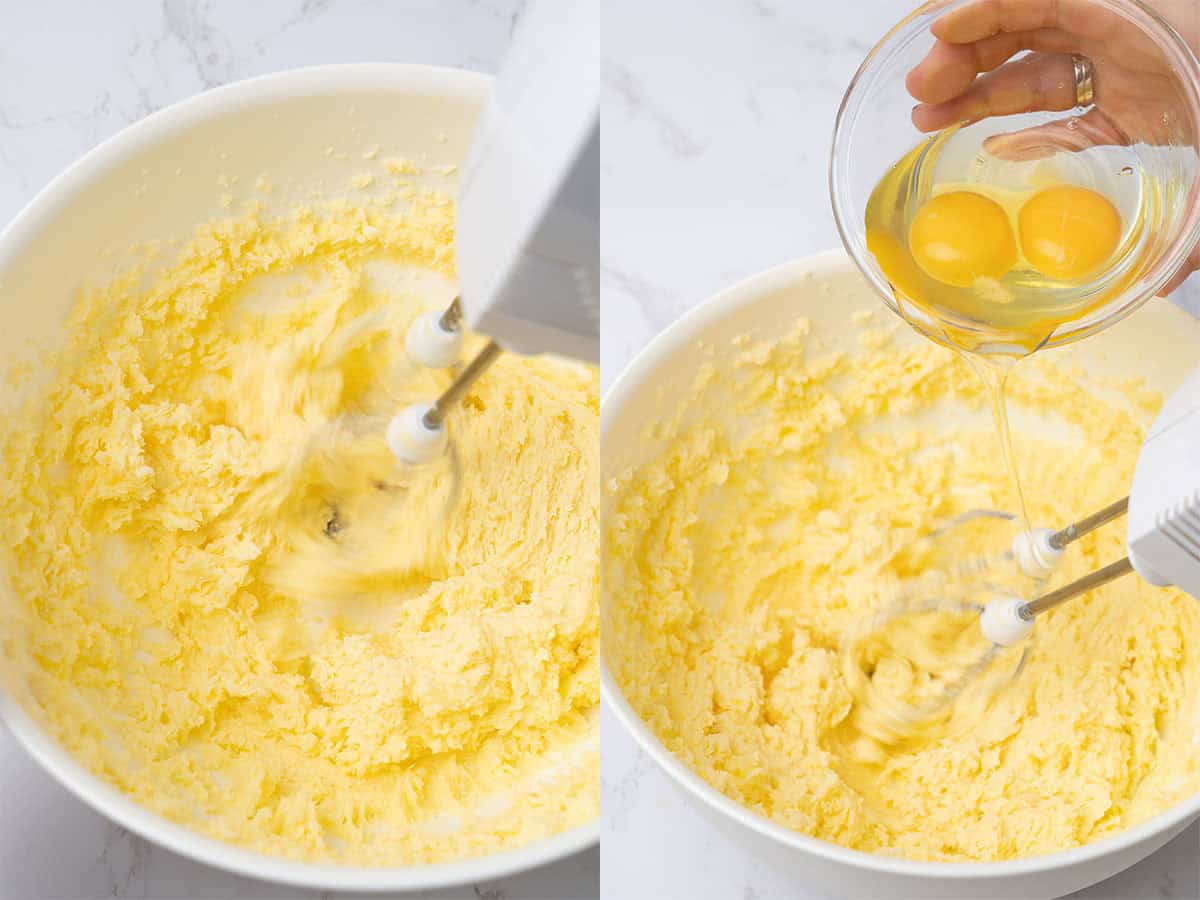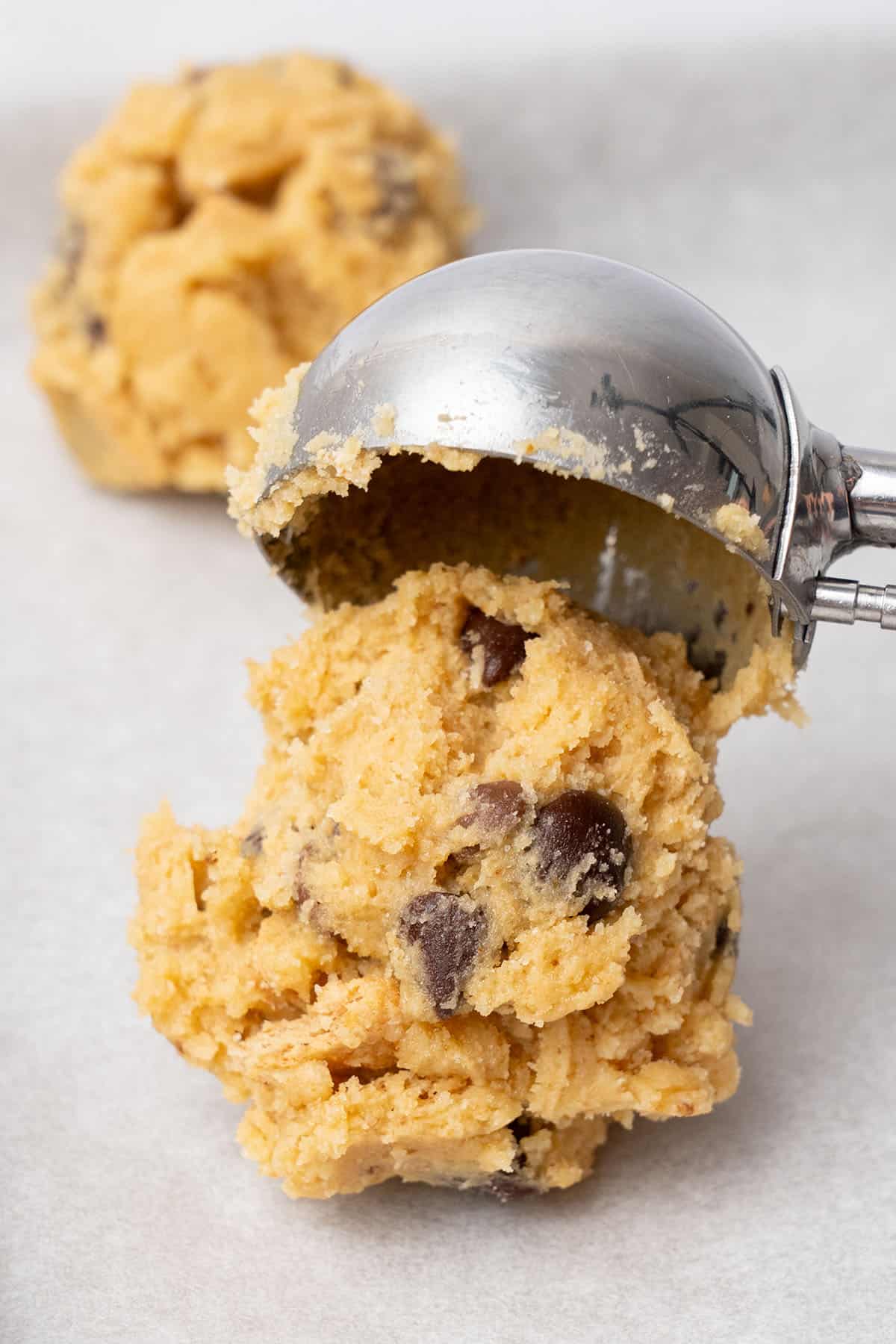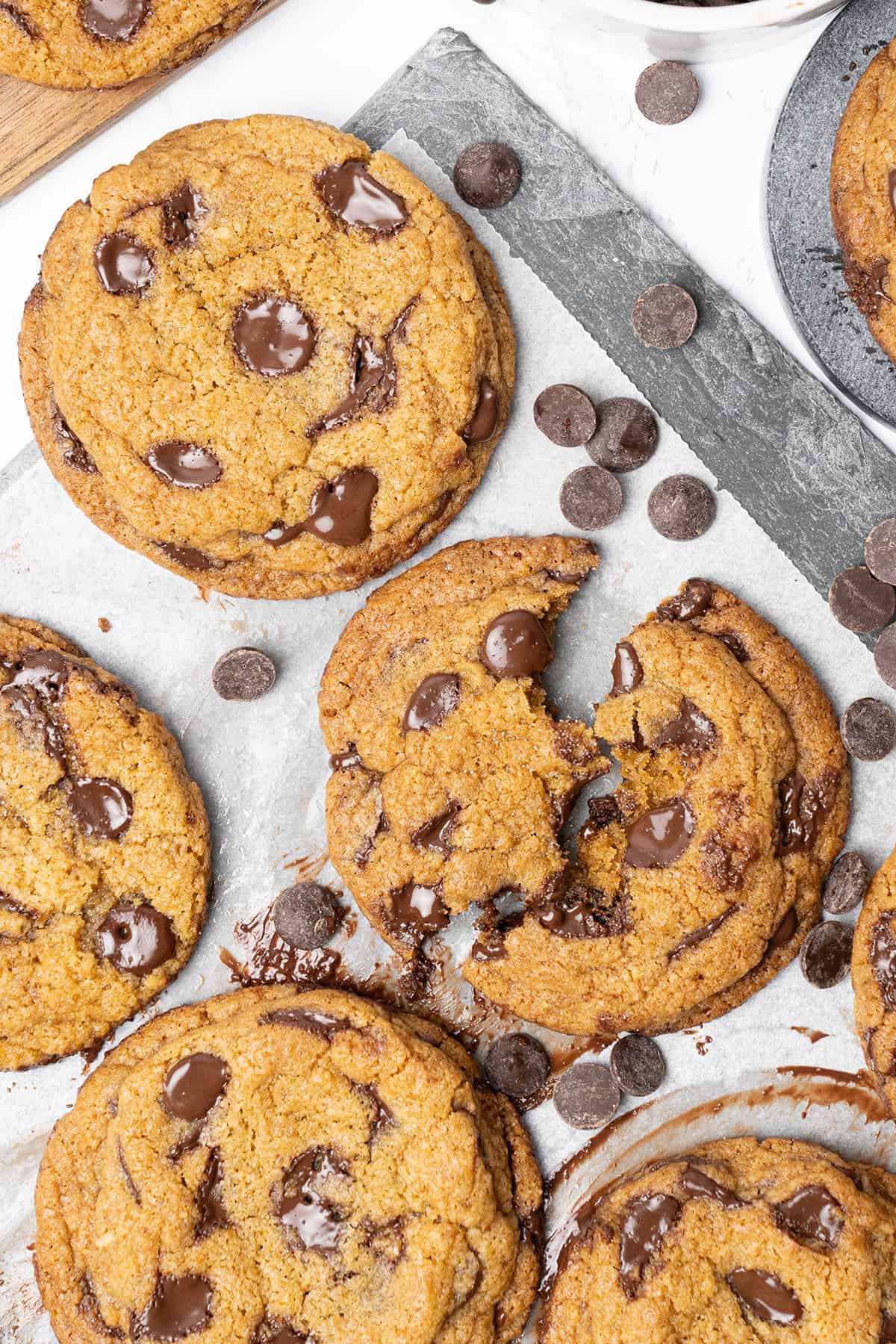I get one baking question more often than others: “Why are my cookies flat?” The truth is, there’s no single answer. This ultimate cookie guide breaks down the 15 common reasons your cookies might spread and how you can fix them, including too soft butter, too hot oven, hot cookie sheet or greased cookie sheet, incorrect ingredient measurements, using the wrong type of fats, skipping the chilling time, undermixed or overmixed the dough, or perhaps the ingredients were low quality or expired, or you accudentially use too few mix-ins, finally sometimes you just baked too many cookies baked at the same time or simply, used a wrong recipe. Additionally, did you know that baking at high altitude also impacts your cookies?
You'll learn about all the mistakes in detail, but most importantly, how to avoid them next time and how to fix them right on the spot.

Why are my cookies flat, and what can I do to fix them?
| Problem | How to fix it |
|---|---|
| Butter was too soft | Let butter sit at room temperature (~19 °C/65 °F) for about 60 min, or briefly chill until pliable but not runny. |
| Oven is too hot | Use a digital oven thermometer to verify and adjust the true temperature. |
| Hot cookie sheets were used | Bake dough only on completely cool sheets; keep two sheets in rotation or cool 5-10 min between batches. |
| Ingredients weren’t measured correctly | Weigh ingredients with a kitchen scale (most accurate) or measure carefully with proper tools. |
| Wrong kind of fat was used | Follow the recipe’s specified fat (e.g., butter vs. oil/shortening); don’t swap without reformulating. |
| Cookie dough wasn’t chilled | Chill dough as directed (often 30 min – 4 h) so butter hardens and dough firms up. |
| Butter and sugar undermixed / overmixed | Cream room-temperature butter and sugar for 2-3 min—fluffy but not broken down. |
| Cookies were rolled too thin | Roll dough to the recipe’s thickness, checking with a ruler. |
| Greased cookie sheets were used | Line sheets with parchment or silicone mats instead of greasing. |
| Baking soda was old or expired | Replace baking soda every ≈ 6 months after opening to keep it active. |
| Too many cookies baked at a time | Space dough balls 2-3 inches apart and bake one sheet at a time on the center rack. |
| Too few mix-ins | Use the full amount of chips/nuts called for, or substitute equal solid add-ins if short. |
| Low-quality ingredients or substitutes | Choose higher-quality brands and avoid untested substitutes unless the recipe creator specifically suggests them or you have the knowledge to reformulate the recipe. |
| Unreliable recipe used | Rely on well-reviewed recipes from trusted, experienced bakers with detailed instructions. |
| High-altitude baking | Add slightly more flour to strengthen the dough. Increase baking temperature and reduce baking time. Reduce sugar and leavening to prevent over-rising and collapse. |
Problem: The butter was too soft
Most cookie recipes call for room-temperature butter. Room temperature butter should be around 19 degrees Celsius /65 degrees Fahrenheit when it's ready to use. It should also be soft and pliable, but not runny.
Room temperature butter can hold air when creamed, which creates a light, fluffy dough that helps your cookies rise properly. Using butter at the right temperature ensures just the right amount of air is incorporated during creaming while also controlling gluten development for the perfect texture. If it is too cold or too melted, it won’t cream properly.
One exception is my brown butter chocolate chip cookies, where the other ingredient ratios compensate for the melted butter.
How to fix it?
Let your butter sit at room temperature for at least 60 minutes to reach the correct temperature. If it has been in the refrigerator for much longer than that and has become very soft or runny, return it to the fridge for several minutes until it's pliable but less soft.
Refer to my guide on how to cream butter to learn more about why this step is important and how to achieve the perfect consistency.

Problem: The oven is too hot
Ovens can vary significantly in how quickly they heat up and how well they bake at the temperatures they are set to. The problem may have nothing to do with the recipe; it could be an issue with your oven.
General temperature variations, as well as hot spots, can cause the cookies to become flat. Overly hot ovens can melt the butter in your cookies before the other ingredients have set, causing the dough to spread much faster than it should during baking.
How to fix it?
Purchasing a digital oven thermometer is a great way to test out the actual temperature of your oven. If you suspect the oven temperature may have been too hot, an accurate oven thermometer can make a big difference in your recipes, even beyond cookies.
Problem: Hot cookie sheets were used
While preheating the oven is always a must, the same isn't true for baking sheets. Always bake the dough on cool cookie trays. If the cookie sheet is hot, the butter will immediately begin to melt, which results in each cookie spreading before it actually bakes.
How to fix it?
Purchase at least two cookie sheets for quick batches, or allow time between batches to let the cookie sheets cool. This usually takes 5-10 minutes.

Problem: Ingredients weren't measured correctly
Take your time when measuring ingredients. The measuring process is just as critical as the mixing of the batter. If you measure the ingredients incorrectly, it can result in a dough that is imbalanced. Too much sugar can cause cookies to come out flat and crispy instead of soft and chewy. This goes for both white sugar and brown sugar.
Not enough flour could also be the culprit, as well as too much fat or too many wet ingredients (i.e., butter, milk, or eggs). The way you scoop your dry ingredients can either add too much or not enough flour to your dough. Too little flour results in an overly wet dough that will not rise properly.
How to fix it?
A kitchen scale is often the most accurate method for measuring ingredients. If your recipe doesn't specify the weight or you don't have a scale, ensure you are using the correct measuring tool to measure accurately.
Having said that, cups and tablespoons can create a lot of dirty dishes, so the safest and quickest way is to use a scale! If, for some reason, you still prefer using measuring cups, you may want to check out my article on converting tablespoons to cups.
Problem: The wrong kind of fat was used
It's essential to use the specific kind of fat called for in the recipe. Standard cookie recipes commonly call for butter, but just because there are similar products that work in cooking doesn't mean you can substitute them in baking.
Using liquid fats, such as coconut oil, can cause a heavy or wet dough, which makes the cookies spread more quickly than intended. On the other hand, substituting shortening for butter will cause the dough to melt more slowly than intended, altering its texture. I explain more about the different baking fats in my article on butter substitutes.
How to fix it?
Be sure to use the correct fat called for in the recipe. For example, you cannot replace butter with oil, margarine, or Crisco without reformulating the recipe. I explain this in more detail in my chocolate chip cookie without butter recipe.
If you don't like to buy a lot of butter at a time but need it for the occasional cookie recipe, you can freeze your butter. When properly stored, it can last for up to four months in the freezer without compromising taste.

Problem: The cookie dough was not chilled before baking
Not chilling cookie dough before baking is one of the most common reasons why your cookies might turn out flat. Since we use room-temperature butter when making the dough, you should always chill the dough before baking, unless otherwise specified in the recipe.
How to fix?
Always refer to the recipe before beginning to plan for dough-chilling time. Typically, cookies require at least 30 minutes to chill, but it's not uncommon for a cookie recipe to call for 2-4 hours or more of chilling time to allow the butter to harden adequately. This not only helps avoid flat cookies but also enhances the flavor of the dough. You cannot skip the chilling time for the cookie dough. Otherwise, the cookies might end up flat.
Problem: The butter and sugar were undermixed or overmixed
As mentioned earlier, creaming the butter and sugar together creates air pockets that help give cookies rise. Creaming them for 2-3 minutes will make the mixture fluffy; however, overmixing can break down the air bubbles you're creating. This happens especially quickly with powerful stand mixers, so be sure to pay close attention and stop the mixer before the batter begins to break.
Just as overmixing can cause issues, undermixing can also cause cookies to spread. Skipping the creaming process can result in less rise and a heavier texture.
How to fix it?
Be sure to start with room-temperature butter. Cold butter won't properly cream. Use the recipe's reference photos and tips to look for the proper texture. Typically, it will take 2-3 minutes to cream the butter and sugar properly using an electric hand mixer.

Problem: The cookies were rolled too thin
When making rolled cookies, such as holiday-themed sugar cookies or gingerbread cookies, it's important not to press the cookies too flat. When rolled too thin, the cookies will not have enough dough to rise properly and may remain brittle and flat after baking. Too-flat cookies may also be prone to overbaking quickly.
How to fix it?
When rolling out cookies, refer to the recipe and use a ruler to ensure the correct thickness. This will help ensure they're the proper size and will bake correctly.
Problem: Greased cookie sheets were used
Nobody likes it when their food sticks to the pan, but using a greased cookie sheet is not a good idea. Buttering the cookie sheet will add extra fat to the dough that can cause the cookies to spread much more than you intended. Not to mention, it will leave you with a greasy mess.
How to fix it?
Rather than greasing your cookie sheets, using silicone baking mats or parchment paper will keep your cookies from sticking and from absorbing unwanted butter into the dough.
Problem: The Baking soda was old or expired
If you find that your cookies are flat, the leavening agents may be the reason. Baking soda gives cookies their rise, but if they are not fresh, they will not work correctly. Cookies that do not puff up will have no choice but to spread out instead!
To clear some confusion on baking powder and baking soda. While these two ingredients look similar, they are not interchangeable. Be sure to read the recipe carefully and follow all the instructions as written.
How to fix it?
Replace baking soda regularly to maintain freshness. You should replace them every six months after you open them. After that time, it may lose potency and negatively affect your baked goods.

Problem: Too many cookies baked at a time
Cookies need space to spread, and overcrowding the baking sheet can cause them to bake into each other and flatten. Baking too many batches at once can also result in flat cookies. When baking cookies, you'll get the best results from cooking one tray at a time.
How to fix it?
Be sure to give the cookie dough balls at least 2-3 inches of space to avoid accidentally baking one giant cookie. At this point, it will not be possible to save with the "cookie-cutter method," which I usually recommend for saving flat cookies (more on this later). Make sure to always bake one tray of cookies at a time on the center rack.
Problem: Too few mix-ins
This might be one of the more surprising reasons for flat cookies, especially with chocolate chip or cookies with add-ins. Not using enough mix-ins can lead to flatter results. Without the right amount of solid ingredients, the dough spreads more in the oven, leaving you with thin, crispy cookies instead of the soft, domed ones you want.
How to fix it?
Be sure to follow the recipes closely and use the listed amount of mix-ins. If you find yourself coming up short on ingredients, try adding an equal amount of chopped nuts or candies to the dough, as I do in my pistachio cookies and chocolate chip walnut cookies.

Problem: Low-quality ingredients or substitutes were used
The baking ingredients you use are very important to the success of a recipe. You may notice that some chocolate chips don't melt quite the same or that using margarine in place of butter causes differences in the recipe's texture. Not all ingredients are created equal, and sometimes low-quality ingredients can impact the quality of your cookies.
How to fix it?
Whenever possible, use high-quality brands for the best possible outcome. If this isn't possible for all the ingredients, choose as many quality ingredients as possible. If you're using a substitute, ensure it's suitable for your specific type of recipe. Unless you are an expert baker, it is best practice not to make substitutions that the recipe developer did not suggest.
Problem: Used an unreliable recipe
Sometimes, it just comes down to the recipe. This is why it is so important to use recipes from trusted and experienced bakers. Some simply copy and paste other recipes without testing, use AI without ever entering the kitchen, and others use misleading images.
How to fix it?
Use a trusted source when looking for recipes online, where the creator of the recipes clearly possesses the necessary knowledge and experience (like this blog). Take reviews and comments into consideration and look for high-quality posts with detailed explanations on how to make and troubleshoot each recipe.
How High Altitude Can Make Your Cookies Flat
Aside from measurements, ingredients, and technique, the altitude at which you are baking can also affect how your cookies turn out. If you live in a high-altitude area (generally above 3,000 feet), you may notice that your cookies turn out flatter than expected, even if you follow the recipe perfectly.
Because lower air pressure above roughly 3,000 ft makes gases in the dough expand sooner and moisture evaporate faster, so cookies spread and end up flatter. Quick fixes: add 1-2 tablespoons of extra flour per cup, chill the dough, and/or increase the oven temperature by about 10 °F (5 °C) while shortening the baking time slightly. If they over-puff and then sink, cut the baking soda by ⅛ teaspoon.
What to do with flat cookies?
In most cases, if cookies spread too much during baking, a round cookie cutter can correct the problem. While the cookies are still warm, you can hold the cookie cutter around each cookie and make circular movements to manipulate their shape before they have set. This will tighten the cookies, making them perfectly round. It's important that your cookie cutter, or the round object you choose, is larger than your cookie and doesn't cut into its sides at all.

You can use this troubleshooting method partway through baking and even after the cookies are done. It's how I achieve the perfect shape, even for cookies that don't spread, such as my pecan chocolate chip cookies. It is also the best solution for fixing chocolate chip cookies that are flat. However, this method will not work if your cookies are already set and chilled. In that case, you'll have to find an alternative way to use your flat cookies.
If you cannot save your cookies, you can use them to make truffles, cookie sandwiches, or cookie butter. You can also use flat cookies as layers in a tiramisu! Flat cookies are perfectly safe to eat as long as they're not burnt. But I've got you. Here is also a guide on what to do with burnt cookies!
Try some of my cookie recipes
- Carrot Cake Cookies
- Chocolate Brownie Cookies
- Lemon Poppy Seed Cookies
- Creme Brulee Cookies
- Danish Butter Cookies
- Tiramisu Cookies
And for even more creative and delicious cookies that all ages will love, check out my roundup of 60+ Different Types of Cookies.

Andrew Jackson
Hi Katalin,
Something I found as a flex for cookies is adding cornstarch. They become amazingly big and round instead of flat.
Tiffany
Great info here!
ROBBIE
A lot of recipes make chewy cookies; however, I prefer and LOVE crunchy, crispy cookies.
How would I be able to make a 'chewy cookie' recipe to come out 'crunchy and crispy?'
Thanks again for sharing all your Tips and Recipes.
Katalin Nagy
If you want crunchy and crispy cookies, simply you should slightly overbake them and let them spread flat. Kind of the opposite of what this article is about:)